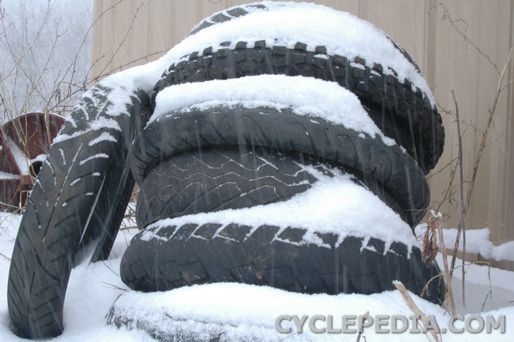
(Here’s an article we wrote for a motorcycle trade publication, with a target audience of motorcycle dealers)
A funny thing happened at the bike shop one day. We were all hanging out in the back, telling lies like a bunch of dirt bikers do, when a guy came up to the back door pushing his bike. He had a tire over one arm while he pushed this XS650 Yamaha into the shop.
“Time for new rubber,” he said, “Ed’s bringing the front.”
Ed was the owner of the shop. We could hear him bustling around in the back finding a tire that would fit and hurrying out to make the sale. Ed, like most shop owners, was eager to sell this customer a set of tires. It was just amazing that it took him this long to do it.
I walked around the back of the XS, and could see four distinct bands of nylon cord showing, maybe five if I looked real hard. “You got your money’s worth out of this one,” I said, knowing that the joke was a dry one–the customer was proud of his frugality.
“Yep,” he said, his rejoinder a classic case of Yankee one-upmanship, “I was ready to let it go til fall, but my girlfriend said she won’t ride on the back unless I get a new one.”
By this time I had made my usual 360 around the bike, stopped at the front, where the tire was merely bald, but not showing any cords. “This one’s still got plenty of life in it.”
“I know,” the customer said, plainly disappointed. “She wants me to change that one too.”
By ths time Ed had made his appearance and was barking orders around the shop, things we’d of course already started in motion. The job at hand was getting the tires on, while the customer waited, get the sale paid for and the job out the door, and then we could get back to whatever it was we were doing before the XS was rolled into the shop.
The question roiling around in anyone’s mind might be, why did the customer wait so long to get new tires? The answer could be simple, considering where we lived. Northern New England is the home of the proudest, cheapest Yankees you’ll ever meet, and riding up with a completely skinned tire is a point of pride for some. Hard to say if they realized exactly how bad a safety hazard a bald tire is on a two-wheeler, especially one that’s being wailed around on local streets, in unpredictable weather. Nobody really goes out intending to risk their life on a motorcycle, but without a doubt worn out tires is a great way to do it.
The second great question would be, why did Ed wait so long to sell this guy a set of tires? Easy. I’ve watched Ed work for quite some time, and his mechanics. Their modus operandi was simple: wait inside, at the counter or in the shop, until somebody came in needing something.
This kind of thinking is great for keeping you out of the weather, but does it bring in extra sales?
Here’s a better approach, that would work in any bike shop. When a customer comes in for parts, why not have your parts guys go out and check their VIN number, just to make sure they’re ordering the right part? While they’re writing down the all-important VIN, they could take a quick walk around the bike, and possibly spot any number of potential sales. “Hey, this tire’s getting a little thin, did you know we have some special deals going on tires this month?” Or how about, “You know, that taillight lens is pretty cloudy, we can fix you up with a new one.”
It’s also a great time to suggest accessories. If you customer has a bag of groceries lashed down to the passenger seat, you might suggest they look at the tailbags you have in stock, or maybe they want a set of saddlebags that’ll get the job done in style.
You’re all familiar with the customer who rides down to the shop on a nice Saturday morning just to hang out with some other motorcycle guys. You know they have their bike there, they wouldn’t be carrying a bug-covered helmet otherwise. Perfect opportunity to say something like, “Hey, you’ve got your bike here? Let’s go take a look at it, I need to get outside…” Customers love to show off their bike, and love to talk about them. Why not steer the conversation towards possible upgrades as well as new parts that might be needed?
If you want to get scientific, have your salesmen carry a tire tread gauge in their pocket, and get right down and check customer’s tires. “You know, that tire won’t pass inspection next time, you might think about something new on there.”
Tires have a lot of other potential problems other than wear. Your service and sales people should be trained to be able to spot dry rot, odd tire wear patterns as well as tread depth, and even look for nails in the tire. I’ve seen a number of customers come in carrying nails and they never had a clue.
The bottom line is this: Your customers come in because they’re interested and enthusiastic about the product you’re selling. Go outside and look at their ride; show a little enthusiasm in return, and you might also find that you’re opening up a new avenue for sales while you’re at it.



Leave a Reply
You must be logged in to post a comment.